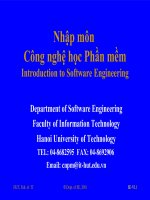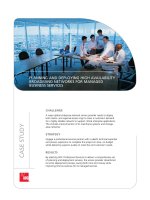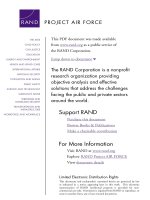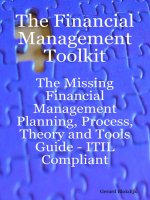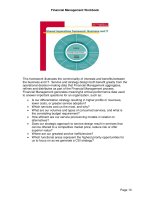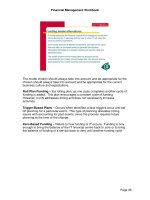Process planning and cost estimation
Bạn đang xem bản rút gọn của tài liệu. Xem và tải ngay bản đầy đủ của tài liệu tại đây (2.49 MB, 220 trang )
Tai Lieu Chat Luong
This page
intentionally left
blank
Copyright © 2007, New Age International (P) Ltd., Publishers
Published by New Age International (P) Ltd., Publishers
All rights reserved.
No part of this ebook may be reproduced in any form, by photostat, microfilm,
xerography, or any other means, or incorporated into any information retrieval
system, electronic or mechanical, without the written permission of the publisher.
All inquiries should be emailed to
ISBN (13) : 978-81-224-2655-7
PUBLISHING FOR ONE WORLD
NEW AGE INTERNATIONAL (P) LIMITED, PUBLISHERS
4835/24, Ansari Road, Daryaganj, New Delhi - 110002
Visit us at www.newagepublishers.com
This page
intentionally left
blank
CONTENTS
Page No.
1.
2.
Preface ...................................................................................................................
(v)
Work study and Ergonomics ...........................................................................
● Method study ......................................................................................................
● Definition .............................................................................................................
● Objectives of Work study ..................................................................................
● Objectives of Method study ..............................................................................
● Basic Procedure for Method Study .................................................................
(Select, Record, Examine, Develop, Define, Install and Maintain)
● Recording Techniques used in Method Study ...............................................
● Work Measurements ..........................................................................................
● Objectives of work Measurements ..................................................................
● Work Sampling ...................................................................................................
● Analytical Estimating ........................................................................................
● Synthesis .............................................................................................................
● Pre-Determined Motion Time System (PMTS) ..............................................
● Ergonomics .........................................................................................................
● Ergonomics Principles Applied to Instrument Design and Control ...........
● Ergonomics Principles Applied to Machines and Controls .........................
● Ergonomics Principles Applied to Layout of a Work place .........................
● Evaluative Questions (Method Study) ....................................................
● Evaluative Questions (Work Measurements) .......................................
● Evaluative Questions (Ergonomics) ........................................................
1 — 47
1
1
2
2
2
Process Planning .................................................................................................
● Product Design ...................................................................................................
● Manufacturing Planning ....................................................................................
● Process Design ...................................................................................................
● Basic Factors Affecting Process Design ........................................................
● Types of Production ...........................................................................................
● Job Production ...................................................................................................
● Batch Production ...............................................................................................
● Mass Production ................................................................................................
48 — 94
48
49
49
50
50
51
52
52
(vii)
7
17
17
21
24
25
26
28
29
32
35
39
43
47
(viii)
●
●
●
●
●
●
●
●
●
●
●
●
●
●
●
●
●
●
●
●
●
●
●
●
●
●
●
●
●
●
●
●
●
3.
Specialization .....................................................................................................
Simplification ......................................................................................................
Standardization ..................................................................................................
Process Planning ................................................................................................
Steps involved (Procedure) in Process Planning ..........................................
Bill of Materials ..................................................................................................
Process Planning Sheet .....................................................................................
Uses of Process Sheet .......................................................................................
Routing ................................................................................................................
Route Sheet .........................................................................................................
Calculation of Man-hours and Machine-hours ..............................................
Uses of Computers in Process Planning and Cost Estimation ...................
Computer Aided Process Planning (CAPP) ...................................................
Approaches to Process Planning .....................................................................
Variant or Retrieval Method of Process Planning .........................................
Generative Method of Process Planning ........................................................
Benefits of CAPP ................................................................................................
Practices of Process Planning .........................................................................
Process Selection ...............................................................................................
Process Planing Activities ................................................................................
Machine Selection ..............................................................................................
Factors Influencing Process Selection ...........................................................
Process Selection Parameters .........................................................................
Material Selection ..............................................................................................
Material Selection Parameters .........................................................................
Documents Required for Process Planning ...................................................
Developing Manufacturing Logic and Knowledge ........................................
Steps in Process Planning .................................................................................
Selection of Cost-Optimal Process ..................................................................
Breakeven Charts ...............................................................................................
Breakeven Point and Breakeven Analysis .....................................................
Evaluative Questions in Process Planning ............................................
Evaluative Questions in Breakeven Point and Breakeven Chart ...
54
54
54
55
56
56
57
59
59
59
60
61
61
62
62
63
63
64
64
65
66
67
67
68
68
69
70
70
76
77
82
92
93
Introduction to Cost Estimation ................................................................... 95 — 117
● Cost Estimating ..................................................................................................
95
● Cost Accounting .................................................................................................
95
● Objectives of Cost Estimation .........................................................................
96
● Components of a Cost Estimate ......................................................................
96
● Cost Estimation Procedure ..............................................................................
98
● Classification of Costing ...................................................................................
100
● Elements of Cost ................................................................................................
102
(ix)
●
●
Cost of Product (Ladder of Costs) ..................................................................
Evaluative Questions in Cost Estimation ..............................................
105
115
4.
Cost Estimation ..................................................................................................118 — 128
● Types of Cost Estimates ....................................................................................
118
● Methods of Cost Estimates ...............................................................................
120
● Data Requirements and Sources of information ...........................................
124
● Allowances in Estimation (of Standard Time) ..............................................
125
● Evaluative Questions in Cost Estimation ..............................................
128
5.
Production Cost Estimation ...........................................................................129 — 193
● Estimation of material cost, labour cost and overhead ...............................
129
● Cost Estimation in Foundry Shop (Casting) ..................................................
129
● Cost Estimation in Welding Shop (Weldments & Welded joints) ...............
134
● Cost Estimation in Forging Shop (Forging) ...................................................
146
● Cost Estimation in Machine Shop (Machined components) .......................
153
● Overhead Expenses ...........................................................................................
181
● Allocation of Overhead Expenses or Distribution of overhead costs .......
182
● Types of Overhead Costs ..................................................................................
185
● Evaluative Questions in Production Cost Estimation .......................
187
●
Model Questions .................................................................................................194 — 195
●
Objective Type Questions ................................................................................196 — 201
●
Model Question Papers ..................................................................................... 202 — 209
This page
intentionally left
blank
1
WORK STUDY
AND ERGONOMICS
METHOD STUDY : Instructional Objectives
After studying this unit the student should be able to :
(i) Define work study and its uses.
(ii) Differentiate between method study and work measurement.
(iii) Decide which type of recording technique is used in a given situation.
(iv) Develop various type of charts and draw inference regarding unnecessary movements and delays.
(v) Suggest improvements in the existing processes and methods for improved productivity.
INTRODUCTION
An industrial undertaking, if it is to survive, must be aware of the latest developments brought
about by continuous application of new technology and methods used in production. It must
continuously strive for improvements in the efficiency of its production and must consistently aim at
producing better quality goods at lower prices than its competitors. The performance of an
undertaking can be improved by :
1. Improving the process of manufacture i.e., by adopting new technology, by developing
better machines and new equipment.
2. Improving the method of operation of existing facilities, equipment, plant and operating
staff.
First of these approaches is called new technology development and is a long-term policy which
deals with extensive improvements and involves heavy capital investment, research and development,
new and improved processes, plant and machinery. The second approach, called Work Study,
concentrates on raising effectiveness and efficiency of existing facilities through systematic analysis
in a relatively short time and in general, with very little or no extra capital expenditure.
DEFINITION OF WORK STUDY
Work study is the study of human work with a view to increase the effectiveness with which the
work is done. As per IS-6363, 1972 work study is defined as “a modern discipline which analyses and
evaluates all aspects of a work system in order to enhance effectiveness and functional efficiency”.
As per International Labour organization, (I.L.O., Geneva, Switzerland) work study is defined as
“a generic term for those techniques, particularly method study and work measurement, which are
used in the examination of human work in all its contexts, and which leads systematically to the
(1)
2
Process Planning and Cost Estimation
investigation of all the factors which affect the efficiency and economy of the situation being
reviewed, in order to affect improvements”.
In simple terms work study may be defined as the analytical investigation of methods, conditions
and effectiveness of work and thereby the determination of the ways in which human effort may be
applied most economically. It is a method used to increase productivity.
Work study embraces two distinct but interdependent techniques, i.e., method study and work
measurement.
Method study may be defined as the detailed analysis of existing or proposed method of doing
the work for the purpose of effecting improvements. Work measurement may be defined as the
determination of time allowed for the effective performance of a specified volume of work performed
in a specified manner.
OBJECTIVES OF WORK STUDY
The main objectives of work study are :
(i) To find the most economical way of doing the work.
(ii) To standardise the methods, materials, tools and equipment.
(iii) To determine the time required to do a job by a qualified and properly trained person
working at normal pace.
(iv) To assist in training the workers for new methods.
METHOD STUDY
Method study is that part of work study which deals with systematic analysis and improvement of
work methods and systems through the application of innovative techniques to achieve better
utilization of resources.
OBJECTIVES OF METHOD STUDY
The objectives of method study are :
(i) To bring improvement in processes and procedures.
(ii) To bring improvement in factory, shop and work-place layout.
(iii) To find the ways for optimum utilisation of resources i.e., men, machines and materials.
(iv) To bring economy in human effort by reducing the unnecessary fatigue and thereby increase
the efficiency.
(v) To develop suitable working conditions.
BASIC PROCEDURE FOR METHOD STUDY
In order to find an effective method for doing a job as well as for optimum utilization of
resources, a systematic approach should be followed for method study. The basic procedure involves
seven stages in the application of methods study. These stages are :
(i) Select the work to be studied.
(ii) Record all the relevant facts about the present method after observation.
Work Study And Ergonomics
3
(iii) Examine these facts critically in the order of sequence using the questioning techniques.
(iv) Develop the most practical, economic and effective method considering all circumstances.
(v) Define the new method (improved method) so that it can always be identified and specified.
(vi) Install the method as standard practice.
(vii) Maintain that standard practice by proper supervision, regular and routine checks.
All these seven steps are essential in the application of method study and none can be excluded.
Also, strict adherence to their sequence as well as their contents is essential.
1. Select the Work to be Studied
One of the main difficulties in the programme of method study is to know where to start. One
should start with a problem, section or area which is expected to give maximum benefit. The
following defects and symptoms will indicate where the method study is likely to bring worthwhile
savings :
(i) Poor use of men, materials and machine capacity.
(ii) Bad layout and poor planning resulting in unnecessary movements of materials.
(iii) Existence of bottlenecks (i.e., problems obstructing smooth flow of work).
(iv) Inconsistencies in quality.
(v) Excess scrap and reworking cost.
(vi) Excessive overtime.
(vii) Highly fatiguing work.
(viii) Bad working conditions and high rates of accidents.
(ix) Frequent complaints by employees about a particular work.
The above indicators show the areas, where method study techniques can be applied for
improvement of the work methods. A work study engineer should first tackle the jobs which are likely
to have greatest overall effect on the productivity of the enterprise as a whole. It should also be
remembered that work study should be readily acceptable to all the workers. For this purpose the jobs
which are unpopular should be taken up first. The objectives of carrying out method study for a
particular job should be clear to the work study/method study engineer at this stage.
2. Record
In order that the activities selected may be analysed fully, with a view to improve them, it is
essential to have a record of all the facts about the existing method. The facts should be recorded
systematically and nothing should be over looked or distorted.
The usual way of recording facts is to write them down but this method is not suitable for
recording of the complicated procedures involved in the modern industry. The following are the most
generally used tools and techniques for recording :
(a) Charts
(i) Outline process chart.
(ii) Flow process charts man type, material type and equipment type.
4
Process Planning and Cost Estimation
(iii) Two handed process chart.
(iv) Multiple activity chart.
(v) Simultaneous Motion (Simo) cycle chart.
(b) Diagrams and models
(i) Flow diagram.
(ii) String diagram.
(iii) Cyclegraph and chronocyclegraphs.
(iv) 2-dimensional and 3-dimensional models.
According to the nature of the job to be studied and purpose for which the record is required, one
or more of the above techniques can be used and every type of normal activity can be recorded to the
appropriate degree of details required. (Some of the above mentioned recording techniques will be
discussed in the later part of this chapter).
3. Examine
Once all the facts relating to an existing method have been recorded, each of the recorded facts is
subjected to critical examination.
Critical examination is the means by which each activity is subjected to a systematic and
progressive series of questions. The objective of critical examination is to determine the true reasons
underlying each event and to draw up a systematic list of all the improvements for later development
into a new and improved method. This stage involves posing a series of questions in an impartial and
objective manner. The stage “Examine” involves Questioning Techniques. The questions are divided
into two categories :
(a) Primary questions : The primary questions indicate the facts and the reasons underlying
them. This stage of questioning technique queries the fundamental need for the performance,
place, sequence, person and means of every activity recorded and seeks a reason for each
reply. The questioning sequence follows a well established pattern which examines :
the purpose for which
the place at which
the sequence in which
the person by whom
the means by which
the activities are undertaken
with a view to : eliminating
combining
re-arranging those activities with a view to bring out improvements.
or
simplifying
(b) Secondary questions : The secondary questions cover the second stage of questioning
technique, during which the answers to the primary questions are subjected to further query
Work Study And Ergonomics
5
CRITICAL EXAMINATION CHART
Primary questions
Secondary questions
The present fact
Challenging the facts
Possible alternative
Selected alternative
Purpose
What is achieved ?
Is it necessary ? Yes, No
(If yes - Why ?)
What else could be
done ?
What should be
done?
Place
Where is it done ?
Why there ?
Where else could it be
done ?
Where should it be
done ?
Sequence
When is it done ?
Why then ?
When else could it be
done ?
When should it be
done ?
Person
Who does it ?
Why that person ?
Who else could do it?
Who should do it ?
Means
How is it done ?
Why that way ?
How else could it be
done ?
How should it be
done ?
to determine whether possible alternatives of place, sequence, person and/or means are
practicable and preferable as a means of improvement upon the existing method. Thus in
this stage of questioning the method study engineer goes on to enquire : What else might be
done ? and hence what should be done ? The following chart shows how, he (Method Study
Engineer) should actually proceed :
The answers to these questions indicate the lines along which a new method for overall process
should be developed. In obtaining the answers to secondary questions, which will be the pointers to
improvement, the following considerations are the most important :
(i) When the purpose of an activity is challenged the main objective is to see whether it can be
eliminated entirely.
(ii) If the activity proves to be essential, then the objective must be to see whether it can be
modified by changing or combining it with some other activities. In some cases it is
possible to obtain improvements by separating and redistributing the work contents of
particular activities.
In this way the improvements are obtained by combining or changing the place where work
is done, the sequence in which activities are performed or the persons performing the
activities.
(iii) Finally when the means of doing job are being considered, attention is given to see how an
activity can be simplified.
4. Develop New Method
The examination of the existing method provides a comprehensive statement of what is being
done at present and shows in which direction improvements may be made. With the results of critical
examination as a guide, the work study engineer can proceed further to develop an improved method.
The developed method should be :
(i) Practical and feasible,
6
Process Planning and Cost Estimation
(ii) Safe and effective,
(iii) Economical,
(iv) Acceptable to design, production control, quality control and sales department.
The development of new method is simplified with the co-operation from staff of other
departments. Human aspect should also be considered carefully and everything reasonable should be
done to ensure comfortable working conditions. Developing a new method, in some cases, may
involve incurring some marginal expenditure, for which the management should agree.
5. Define the New Method
The work study engineer should prepare complete instruction sheets for the revised method or the
new method to be introduced. The instruction sheet should cover all details of the new method and
should be written out in straight forward terms, so that there is no confusion and no two different
meanings can be taken from it. The instruction sheet serves the following purposes :
(i) It records the improved method for future reference in as much details as may be necessary.
(ii) It can be used to explain the new method to the management, foremen, supervisor and
operating staff. It also advises all concerned of any new equipment required or new
workplace design.
(iii) It is an aid to training of operating staff and can be used by them for reference until they are
fully conversant with the new method.
(iv) It forms the basis on which time studies may be taken for setting standards etc.
New method arrived at is known as Written Standard Practice/Procedure which outlines the
method to be used by the operator and a copy of it should be displayed or kept near the work spot.
6. Install the New Method
The process of installing a new (improved) method is very critical and requires co-operation and
active support of everyone concerned. The new method should be introduced after adequate preparation
has been made. Installation involves introduction of developed method as standard practice.
If the physical facilities are to be altered due to installation of the new method, these changes
should generally be made outside the normal working hours so that it would not affect regular
production. Provision should be made for training the workers on the new method. The workers will
take some time to learn the new method, and this should be taken into consideration in estimating the
output in initial stages. As a result of new method some workers may have to be displaced from old jobs,
so alternative work should be found out for them before the installation of the new method in practice.
7. Maintain the New Method
It is important that when new method is installed it should be maintained in its specified form and
the workers should not be allowed to slip back into old methods or introduce any further changes
which are not allowed. Checking by work study department is necessary to maintain the application of
new method, because if there is no check, the workers, foremen, supervisor and chargeman will tend
to gradually fall back to the old method. It should be ensured that the new method is established as
Work Study And Ergonomics
7
standard procedure and it is protected from unauthorised changes. Routine checks and verifications
ensure the proper functioning of the installed method. Reasons for deviations, if any, should be
explored and the necessary change may be made in the procedure being followed.
The views of operating staff, foreman, supervisor etc. may help in further improvement of the method.
RECORDING TECHNIQUES USED IN METHOD STUDY
A. Charts
Symbols used in charting : The following are the symbols used in the construction and
interpretation of the charts.
Symbols Used in the Construction of Charts
Symbol
Activity
Example
Operation
Produces, accomplished or enables the
process to be carried out.
Transport
Travel, movement of men equipment or
materials etc.
Inspection
Verifies quality and/or quantity.
Delay
Delays, men, material, or machine in waiting.
Storage
Holds, keeps or retains the material.
Operation and transport
(combined operation)
Painting or drying of parts on a conveyor.
Operation and inspection
(combined operation)
Operation (closing of caps) and inspection
of quantity in bottles.
Depending upon the job being studied and the details required two or more of the above symbols
may be used.
1. Process Charts
A process chart is a graphic representation of the sequence of events and related information that
occur in the work method or procedure. The following are the various types of process charts :
8
Process Planning and Cost Estimation
(i) Outline process chart.
(ii) Flow process chart.
(iii) Two handed process chart.
(i) Outline Process Chart
The outline process chart gives an overall view of the process, from the beginning to the end. It is
a graphic representation of the sequence of all the operations and inspections carried out in the entire
process and the stage at which material is introduced. In outline process chart only operation and
inspection symbols are used. In addition, a brief note of the nature of each operation or inspection is
made along side the symbol and time allowed for it is also entered. An example of outline process
chart is shown in Fig. 1.1.
Fig. 1.1. Outline process chart for nut, bolt and washer assembly
If the final product is assembled from several subsidiary components or materials which join the
major process during its progress, the major process is shown starting from the right hand side of the
page and subsidiary processes are joined to the major process at the place of entry of the materials or
subassemblies. All the operations are sequentially numbered; similarly all the inspections are sequentially
numbered separately.
Work Study And Ergonomics
Summary
Method
Company
Present Proposed Savings
No. of Page
Plant
No. of storages
1
No. of transportations
5
Department
No. of Operations
5
Job
No. of Inspections
1
No. of Delays
0
Date
Man or
Material
Distance travelled-meters
Chart Begins : Man in the work place.
Time per cycle-minutes
Chart Ends : Man places the welded plates in storage.
Total cost per month
Charted by :
1. Operator goes to collect individual plates
2. Collects plates
3. Goes to almirah to collect welding rods, bins etc.
4. Collects welding material
5. Goes to work place
6. Keeps the plates and other material at work place
7. Goes to switch on electric supply
8. Makes the electric connection etc.
9. Comes back to work place
10. Does the welding
11. Inspects the welded plates
12. Keeps the welded plates in storage bin
13.
14.
15.
Fig. 1.2. Flow process chart (Man type)
Time in Minutes
Delay
Inspection
Operation
Transportation
Storage
Details of (Present) Method
Distance in Metres
Cost of change to proposed method
Notes
9
Process Planning and Cost Estimation
10
Summary
Method
Present Proposed Savings
Company
No. of Page
Plant
Date
No. of storages
1
Department
No. of transportations
2
Job
No. of Operations
5
No. of Inspections
1
No. of Delays
1
Material
Man or
Distance travelled-meters
Chart Begins : Material in the bin.
Time per cycle-minutes
Chart Ends : Finished job in storage bin.
Total cost per month
Charted by :
1. Pick-up job to be drilled
2. Take job to drilling machine
3. Place job in drilling jig
4. Clamp the job
5. Start drilling machine
6. Drill the hole in the job
7. Unclamp the job
8. Inspect
9. Take job to storage
10. Job kept in storage bin
11.
12.
13.
14.
15.
Fig. 1.3. Flow process chart (Material type)
Time in Minutes
Delay
Inspection
Operation
Transportation
Storage
Details of (Present) Method
Distance in Metres
Cost of change to proposed method
Notes
Work Study And Ergonomics
11
(ii) Flow Process Chart
A flow process chart is a graphical representation of the sequence of all operations,
transportations, inspections, delays and storages occurring during a process or procedure, and
includes information considered desirable for analysis such as time required and distance moved.
As per IS-6363-1972, flow process chart is defined as a process chart setting out the sequence of the
flow of a product or a procedure by recording all events under review using the appropriate process
chart symbols.
First cycle
L.H. (Left Hand)
R.H. (Right Hand)
To bolt
1
1
To 1st washer
Pick up bolt
1
1
Pick up washer
To position
2
2
To position
Hold
1
2
Assemble to bolt
3
To 2nd washer
3
Pick up washer
4
To position
4
Assemble to bolt
5
To nut
5
Pick up nut
6
To position
6
Assemble to bolt
1
Delay
7
To Ist washer
To box
3
Put Aside in box
2
Second cycle
To bolt
4
Fig. 1.4. Two-handed process chart. Job : Assemble two washers and a nut to bolt.
12
Process Planning and Cost Estimation
Types of flow process chart :
(a) Man-type : A flow process chart which records what the worker does and his movements.
(b) Material type : A flow process chart which records what happens to material and its
movements.
(c) Equipment type : A flow process chart which records how the equipment is used and its
movements.
It is essential that the activities of only a particular subject to which it refers, either man, material
or equipment are recorded on any single chart i.e., a chart should represent flow of either man,
material or machine at a time. The flow process chart is constructed in the same way as outline
process chart but it uses all the five symbols for charting. A man-type flow process chart for welding
of two plates is shown in Fig. 1.2. The material type flow process chart is shown in Fig. 1.3.
(iii) Two-handed Process Chart
Two-handed process chart is a specialised form of process chart and gives a graphical
representation of work and movement of the operator’s two hands in relationship to one-another. A
two handed process chart is made up of two columns in which are recorded the symbols representing
the activities of the left and the right hand respectively. Recording, in this case, is made with ordinary
symbols with the omission of the inspection symbol since inspections will be shown as movement of
hands. Also the triangle symbol used for storage implies “hold” in two handed process chart. An
example of two handed process chart is shown in Fig. 1.4.
2. Charts Using Time Scale
(i) Multiple Activity Chart
A multiple activity chart is a chart on which the activities of more than one subject (such as a man
and a machine, operator and machines, two or more workers) are recorded on a common time scale to
study their interrelationship. It is a graphical representation of the co-ordinated activities of man and
machine in terms of independent work, combined work or waiting. The chart is constructed by
alloting separate bars to represent the activities of each worker or machine, against a common time
scale. This type of chart is used when the work study analyst is interested in determining ineffective
time within the process or procedure. The multiple activity chart clearly shows when a man or
machine is idle during the process and action can be taken to utilise this time by rearranging the work.
These charts are also constructed when one operator has to operate more than one machine. An
example of multiple activity chart is shown in Fig. 1.5.
(a)
Work Study And Ergonomics
13
(b)
Fig. 1.5. Multiple activity chart
Consider a situation in which time to set up machine is 0.5 minute and machining time is 0.75
minute. As shown in the man-machine chart, when operator is working on one machine, he is idle for
0.75 minute per cycle. Whereas when he is operating two machines simultaneously, he is idle for 0.25
minutes only.
(ii) Gang Chart
When a group of men and equipment are involved in a combined activity, the chart plotted to
show the individual activities of men or the equipment is known as gang chart. Gang chart are used in
moulding (foundry) operations where a gang of 3 or 4 operators and equipment are employed.
(iii) Simultaneous Motion (Simo) Cycle Chart
Simo chart is used to record, simultaneously on a common time scale, the activities of two hands
or other parts of worker’s body during the performance of a single cycle of operation being
investigated. The Simo chart is usually based on film analysis to record the Therbligs or groups of
Therbligs performed by different part of the body of one or more workers. Therbligs are the symbols
used to denote the various activities and movements done for different purposes. Fig. 1.6 shows the
Therbligs used to represent the different movements of body such as eyes, hands etc.
B Diagrams and Models
Although the flow process chart shows the sequence and nature of movements in a process or
procedure it does not provide any information about the path of movements. Sometimes it is of
interest to the work study engineer to know the path of movement of men and materials. It is
necessary to avoid undesirable features like bottle-necks, backtracking, congestion and unnecessary
movements of men or machines through long distances. To investigate such situations, use of
diagrams and models is made. These models and diagrams are widely used in plant layout and
material handling studies because it is important to visualise the number of movements made by the
workers or materials or equipment between facilities and different work stations and accordingly
change the plant layout at design stage itself. So, their unnecessary movements and back tracking of
materials can be avoided.
14
Process Planning and Cost Estimation
Symbol
'
Name of symbol
Description
Search
Locate an article
Find
Mental reaction at end of search
F
Select
Selection from a number
St
Grasp
Taking hold
G
Hold
Prolonged grasp
H
Transport loaded
Moving an article
TL
Position
Placing in a definite location
P
Assemble
Putting parts together
A
Use
Causing a device to perform its function
U
Disassemble
Separating parts
DA
Inspect
Examine or test
I
Pre position
Placing an article ready for use
PP
Release load
Release an article
RL
Transport empty
Movement of a body member
TE
Rest
Pause to overcome fatigue
R
Unavoidable delay
Idle-outside person’s control
UD
Avoidable delay
Idle-within persons’ control
AD
Plan
Mental process before action
Pn
Abbreviation
Sh
Fig. 1.6. Therbligs showing various movements of body members such as eyes, hands etc.
(i) Flow Diagram
Flow diagram is a drawing, made to a scale of the workplace showing the location of various
equipment and machines, activities carried out and the routes followed by workers and materials. The
routes followed in movement are shown by joining the points in a sequence, by a line which
